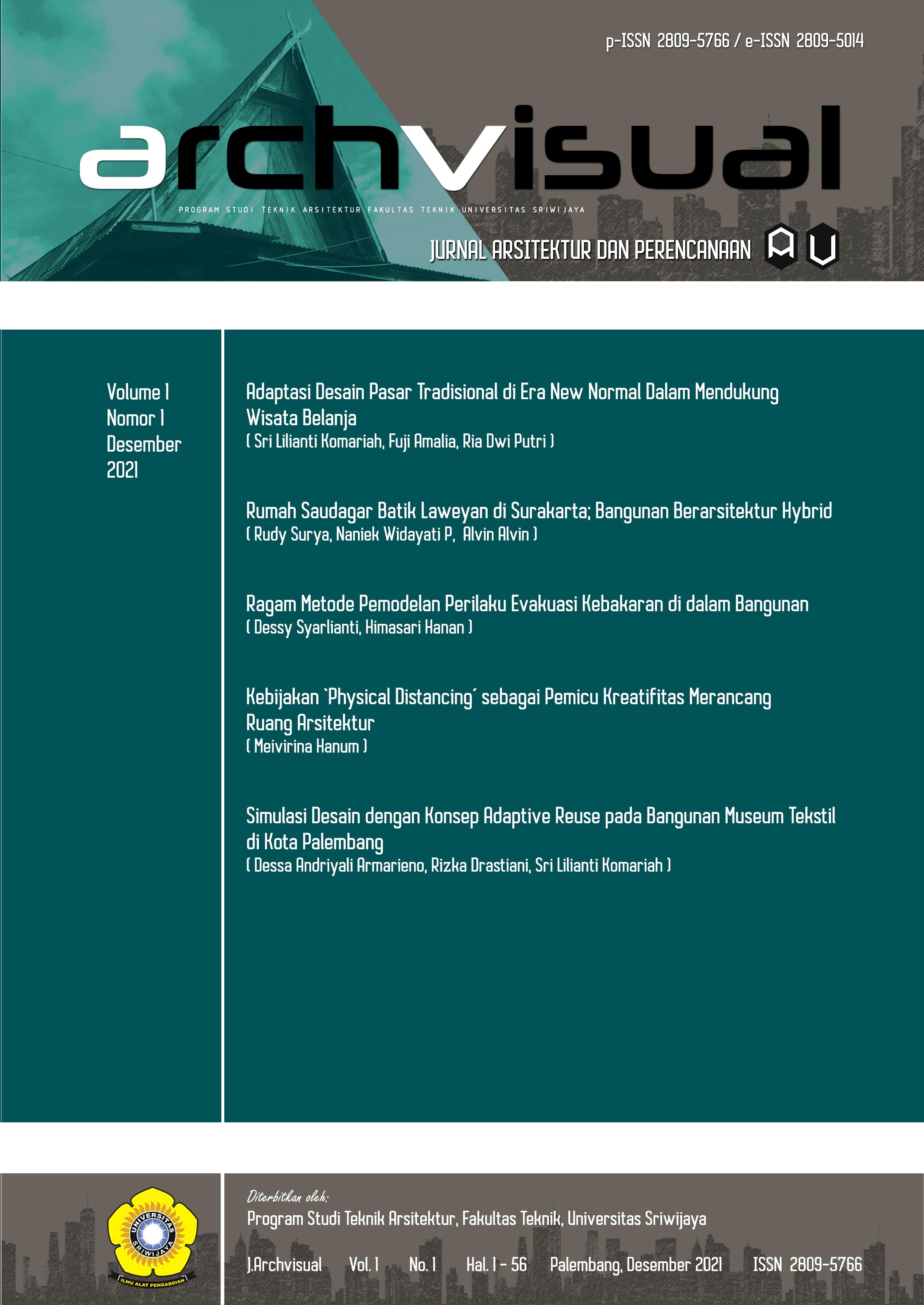Simulasi Desain dengan Konsep Adaptive Reuse pada Bangunan Museum Tekstil di Kota Palembang
Main Article Content
Abstract
One of the key aspects about the importance of history of the city is about how we manage and maintain the persistence of the heritage building. As we know that there is always a value behind the journey of the city with all the story left behind. If we look at closely, the story behind the development or how the city grew up is one of the key elements that can affect the existence of the city. Palembang City with the various issue and development happened has change the image of the city drastically. However, with the development going on incessantly, we hope that it goes well by avoiding demolition or other action that can remove the history of the city. One of them is the issue about the existence of the heritage building. Unfortunately, in some place where the heritage building exists, we easily can find the fact that many of them not maintain very well, so that it decreases the value and quality of the building. One of the reasons is the lack of awareness and concern of the society that significantly affect damage. The fact that there is the regulation made to protect the existence of the heritage building. The decreased of the building also the main reason the value of the area around drop drastically. Historical aspect related to alteration of form and function is explored through qualitative analysis by observing and collecting data in order to perform design simulation. Adaptive reuse is one of the ways to treat heritage well an an appropriate action to keep and maintain the identity and character of the building. In the qualiative method, adaptive reuse is set to applied in Museum Tekstil Palembang in order to revive the activity and increase the economic value surrounding.
Article Details
Section

This work is licensed under a Creative Commons Attribution-NonCommercial 4.0 International License.
How to Cite
References
Attoe, W. (1989). Perlindungan Benda Bersejarah. Dalam Catanese, Anthony J. Dan Snyder, James C. (Editor). Perencanaan Kota: 413-438. Jakarta: Erlangga.
Badan Pelestarian Pusaka Indonesia. (2003). Piagam Pelestarian Pusaka Indonesia. http://www.indonesianheritage.org/produk-hukum/74-piagam-pelestarian-pusaka-indonesia.html>.
Budiharjo, Eko. (1997). Arsitektur Pembangunan dan Konservasi. Jakarta: Djambatan.
Budiharjo, Eko. (1997). Arsitektur sebagai Warisan Budaya. Jakarta: Djambatan.
Devitasari, Amalia, Atik Suprapti, and Bangun I. R. Harsritanto. (2021). Adaptive Reuse Approach towards Visual Character Change in Conservation Building. ARTEKS: Jurnal Teknik Arsitektur 6 (3). https://journal.unwira.ac.id/index.php/ARTEKS/article/view/1141>.
Dobby, A. (1978). Conservation and Planning. London: Hutchinson.
Du, Darren. (2011). New Art Deco Style. China: Liaoning Science & Technology Publishing House.
Orbasli, Aylin. (2008). Architectural Conservation. Singapore: Blackwell.
Purwantiasning, Ari Widyati. (2013). Kajian Konsep
Adaptive Reuse Sebagai Alternatif Aplikasi Konsep Konservasi. Jakarta : FT UMJ.
Sulistyo, Ary (2020). Jakarta dari Masa ke Masa: Kajian Identitas Kota melalui Tinggalan Cagar Budaya. Berkala Arkeologi Sangkhakala 23(1). Medan, Indonesia, 1-17. https://doi.org/10.24832/bas.v23i1.387>.
Tongaroon, N. (2020). Building Reimagined: A Dialogue Between Old and New. International Journal of Building, Urban, Interior and Landscape Technology (BUILT), 16, 83-86 https://ph02.tci-thaijo.org/index.php
/BUILT/article/view/242052>.
Wihardyanto, Dimas & Sudaryono, Sudaryono. (2020). Arsitektur Kolonial Belanda Di Indonesia Dalam Konteks Sejarah Filsafat Dan Filsafat Ilmu. Langkau Betang: Jurnal Arsitektur. 7. 42. http://dx.doi.org/10.26418/lantang.
v7i1.35500>.
Yayasan Untuk Indonesia. 2005. Ensiklopedi Jakarta, Culture & Heritage. Jakarta.

